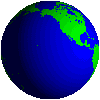 |
GPS SYSTEMS |
 |
 |
GPS SYSTEMS |
 |
The Global Positioning System (GPS) is a location system based on a constellation of about 24 satellites orbiting the earth at altitudes of approximately 12,500 miles. GPS satellites are orbited high enough to avoid the problems associated with land based systems. Still, they can provide accurate positioning 24 hours a day, anywhere in the world. The GPS network was developed by the United States Department of Defense, for its tremendous application as a military locating utility. Billions of dollars have been invested in creating this technology for military uses. In the 1980s, the government made the GPS system available for the public to purchase and use.
Today, many industries are leveraging off the Department of Defense's massive undertaking. As the units are becoming smaller and less expensive, there is an expanding number of applications for GPS. In transportation applications, GPS assists pilots and drivers in pinpointing their locations and avoiding collisions. Farmers can use the equipment to control accurate distribution of fertilizer and other chemicals. Recreationally, GPS is used for providing accurate locations and as a navigation tool for hikers, hunters and boaters.

The future of GPS is in the field of Geographic Information Systems (GIS). Simply put, a GIS combines layers of information about a place to give you a better understanding of that place. With some consideration for error, GPS can provide any point on earth with a precise location. GPS tells you that you are at point X,Y,Z while GIS tells you that X,Y,Z is an oak tree, or a spot in a stream with a pH level of 5.4. GPS tells us the "where", while GIS tells us the "what". GPS/GIS is reshaping the way we locate, organize, analyze and map our resources.
Top of Page --
Home--
GPS --
Accuracy --
GPS Satellite System
The Satellite Signal --
Sources of Signal Problems --
Printable Summary
Experimentation and Results --
Who We Are --
Project Sources